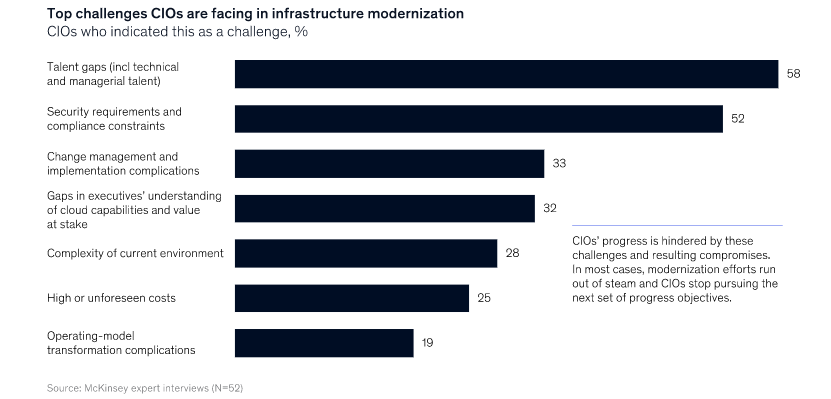
The world health pandemic, COVID-19 has incapacitated businesses by impacting their productivity as well as overall economic growth. It has immobilized their employees, making them work remotely. COVID-19 has also presented the greatest career challenge to the CIOs, i.e. ensuring business continuity by taking care of data availability, employee engagement, and enabling business operations in the time of crisis.
Meanwhile, CIOs have been facing challenges in infrastructure (IT) modernization for a long time. In a report by McKinsey, the major challenges in pursuing IT modernization include security requirements & compliance constraints, talent gaps (including technical & managerial), operational model transformation cost, the complexity of the current environment, and many others.

Due to the outbreak of COVID-19, everyone, including employees, partners, clients, and other business stakeholders are working together but at different locations. Thus, it is important to ensure that their digital workspaces have the required data & information, hardware, software, or any IT resource for that matter. To do that, CIOs have to ensure the following for the business stakeholders:
- Technology Enablement: CIOs have to ensure that all the stakeholders are able to collaborate, can access data & productivity tools. This enables the baseline to work remotely.
- Capacity Management: Capacity management, in general, is planning to ensure that a business maximizes its potential activities, resources, and production output, all the time, under all conditions. For upfront capacity planning, the adoption of cloud-based services should be encouraged.
- Security: When developing a remote working environment, CIOs need to ensure that security at all levels is maintained. This may include providing updated passcodes, authenticating their systems, providing security against scams and phishing attempts, etc.
For businesses to ensure continuity in operations during the COVID-19 outbreak, cloud services can be considered as a comprehensive solution. There are different ways cloud services can be utilized to create a Business Continuity Plan (BCP). Here are a few of them:
1. Migration to Cloud
Cloud migration refers to the process of moving applications, data, and other business elements from a private cloud (on-premise environment) to public cloud services such as Google Cloud Platform (GCP), Amazon Web Services (AWS), Microsoft Azure, etc. Apart from this, cloud migration also refers to moving data & applications from one cloud platform to another (for example, moving from GCP to AWS).
There are various reasons behind moving data and applications to the cloud. One of the prime reasons is ‘accessibility’. When on-premise to cloud migration is adopted, the data & applications that are restricted to be accessed in a centralized location can be accessed from anywhere in the world.
Apart from accessibility, there are different benefits that on-premise to cloud migration has to offer. Reduced CapEx/OpEx, pay-as-you-go pricing models, compliances, DR/HA are some of the advantages that cloud services bring along.
By migration to the cloud, businesses can move their digital services and applications running on-premise to any of the cloud services to make them accessible outside office premises so that all business stakeholders can access them during the lockdown period, keeping security into strict consideration.
2. Controlling Cloud Operational Cost (OpEx)
CapEx and OpEx are two major expenditures that businesses incur in acquiring, maintaining, and operating infrastructure. Capital Expenditure (CapEx) is the cost that a business invests in acquiring, upgrading, and maintaining physical assets. This can be anything, right from an application server, database, networking capacity, storage, development stack, software licenses, etc.
Operational Cost (OpEx), on the other hand, is the cost that a business incurs to keep the business running. This includes, but is not limited to the human resources, environment, and space for servers, inventory cost, operating system, funds allocated for R&D, etc. Migration to the cloud offers the benefit of reducing both the CapEx and OpEx associated with business development.
However, if your business is already on the cloud but still experiences high CapEx and OpEx, then it is important to do an analysis and create an execution plan to ensure how these costs can be optimized. This may involve a thorough assessment of the existing cloud service provider, understanding the cost associated with each service, alternatives of the services in-use, and then taking steps to optimize the cloud-services to ensure that minimum OpEx and CapEx are incurred when the cloud is adopted.
ALSO READ: Tips to Optimize the Infrastructure on Cloud
3. Developing Cloud-Native Solution
For businesses that have new software development projects in the roadmap, it is a great deal to go for cloud-native applications, instead of the traditional solution. Cloud-native applications natively utilizes the infrastructure and services of cloud computing providers.
These applications take advantage of cloud-computing frameworks (storage, compute, network, etc.). The services in a cloud-native application are broken down into small services, called microservices wherein each service is loosely coupled and is independent of each other.
- In cloud-native applications, the infrastructure does not run locally. Since the entire infrastructure is hosted on the cloud, the application thus developed is able to withstand hardware failure.
- The cloud-native approach to development frees the operations team to manually manage the infrastructure resources. Once an application is deployed on cloud infra, the underlying compute, network or storage resources manage the operations.
- Since the services in a cloud-native application are independent, any change in an application won’t affect the entire solution. You can find out more benefits of a modular architecture for the development and conclude why building independent services and that too on cloud is a perfect combination for application development.
4. Containerization
Developers usually write code in their local environment and when they push it from staging to production, the incompatibility in environments creates the trouble. The code that works perfectly on the staging environment might not work smoothly on the production server. Such portability issues generally account for the difference in OS, libraries, and dependencies.
This problem is resolved by containerization. By separating the code from the underlying infrastructure, containerization ensures that developers can pack the code (with bins and libraries) into a small container image that is independent of the environment.
By converting VM based applications into a container ready solution, the following advantages can be availed:
- Containers have lightweight front and thus have lesser operational cost
- Containers have a self-healing architecture and thus needs fewer maintenance efforts
- Containers have independent service scaling capabilities
5. Setting Up HA, DR, & Security Process
High availability, disaster recovery, and security are the key components of a business continuity plan. For many, it’s a belief that being on cloud automates HA, DR, and security processes, which is 30% true.
Despite the cloud service providers offering the most efficient availability support in the background, it’s not enough for businesses to recover from disaster and resume operations with as little disruption as possible. To ensure HR/DA capabilities in a cloud environment, it is necessary to analyze the existing architecture and add security services as per the requirement of the application.
How to Include Cloud in Business Continuity Plan (BCP)?
Depending upon the business situation, size, complexity, and time, various aspects of cloud services can be included in a BCP. To do so, you’ll need to have a technology partner who aces the CloudOps and DevOps practices for seamlessly moving services between on-premise, hybrid cloud, multi-cloud, or simply a cloud environment.
Understanding the need for infrastructure modernization amid the COVID-19 crisis, if your business wants to prepare for the future, then now is the time to act. To know how your business can benefit from the cloud services, set-up a free consultation with our cloud-expert, Gaurav Sharma.



